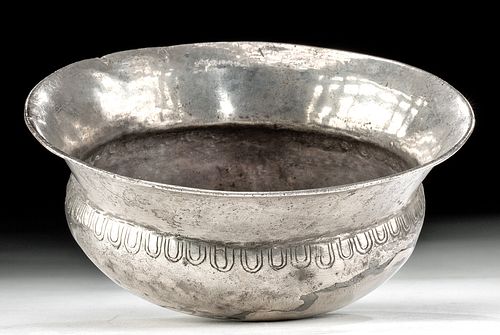Greek Hellenistic Silver Libation Bowl w/ Omphalos
Lot 23b
About Seller
Artemis Gallery
686 S Taylor Ave, Ste 106
Louisville, CO 80027
United States
Selling antiquities, ancient and ethnographic art online since 1993, Artemis Gallery specializes in Classical Antiquities (Egyptian, Greek, Roman, Near Eastern), Asian, Pre-Columbian, African / Tribal / Oceanographic art. Our extensive inventory includes pottery, stone, metal, wood, glass and textil...Read more
Categories
Estimate:
$4,000 - $6,000
Absentee vs Live bid
Two ways to bid:
- Leave a max absentee bid and the platform will bid on your behalf up to your maximum bid during the live auction.
- Bid live during the auction and your bids will be submitted real-time to the auctioneer.
Bid Increments
| Price | Bid Increment |
|---|---|
| $0 | $25 |
| $300 | $50 |
| $1,000 | $100 |
| $2,000 | $250 |
| $5,000 | $500 |
| $10,000 | $1,000 |
| $20,000 | $2,500 |
| $50,000 | $5,000 |
| $100,000 | $10,000 |
| $200,000 | $20,000 |
About Auction
By Artemis Gallery
Feb 13, 2020
Set Reminder
2020-02-13 10:00:00
2020-02-13 10:00:00
America/New_York
Bidsquare
Bidsquare : Exceptional Antiquities, Asian, Ethnographic
https://www.bidsquare.com/auctions/artemis-gallery/exceptional-antiquities-asian-ethnographic-4848
An important one-day auction featuring museum-worthy examples of Egyptian, Greek, Roman, Etruscan, Near Eastern, Far East / Asian, Pre-Columbian, African / Tribal, Oceanic, Native American, Spanish Colonial, Russian, Fossils, Ancient Jewelry, Fine Art, so much more! Artemis Gallery info@artemisgallery.com
An important one-day auction featuring museum-worthy examples of Egyptian, Greek, Roman, Etruscan, Near Eastern, Far East / Asian, Pre-Columbian, African / Tribal, Oceanic, Native American, Spanish Colonial, Russian, Fossils, Ancient Jewelry, Fine Art, so much more! Artemis Gallery info@artemisgallery.com
- Lot Description
Greece, Hellenistic Period, ca. late 4th to 3rd century BCE. A delicate 97.5% silver phiale, a special libation bowl used for holding wine, with a hollow, rounded, raised boss, known as an omphalos, in the center. The omphalos is thought to have symbolized the navel of the earth, the central point of power that all things revolved around. The bowl is bulbous on its lower two-thirds before abruptly flaring out to form a wide mouth. Etched delicately around the shoulder just below that flaring mouth is a band of vertical, abstract acanthus leaves. Size: 5.45" W x 2.5" H (13.8 cm x 6.4 cm); silver is 97.5%; total weight: 64.2 grams
Libation bowls, known as phiale, were used across a wide geographical area - from Greece to Tibet, throughout the ancient Near East and Central Asia. These shallow bowls for holding wine in ritual and ceremonial settings were made from many materials - glass, ceramic, and many kinds of metal. Royal vessels were made of precious metals, like this one. They functioned both as tableware and as wealth - they could be stored in the royal treasury or given as gifts to people they were hoping to influence.
Provenance: private East Coast, USA collection; ex-Neil Phillips collection, New York, USA, acquired in the 1990s
All items legal to buy/sell under U.S. Statute covering cultural patrimony Code 2600, CHAPTER 14, and are guaranteed to be as described or your money back.
A Certificate of Authenticity will accompany all winning bids.
We ship worldwide and handle all shipping in-house for your convenience.
#152783Repaired on base with some small losses along the repair lines and some small areas (as shown on the underside) where new material was added to create the repairs. Also a small area of loss under the rim on one side. Slight bending to form, notably around the rim, with tiny nicks and scratches on surface. Patina has been cleaned in some places but remains in others. Overall form is well preserved and the decorative details are also in very nice condition.Condition
- Shipping Info
-
All shipping is handled in-house for your convenience. Your invoice from Artemis Gallery will include shipping calculation instructions. If in doubt, please inquire BEFORE bidding for estimated shipping costs for individual items.
-
- Buyer's Premium



 EUR
EUR CAD
CAD AUD
AUD GBP
GBP MXN
MXN HKD
HKD CNY
CNY MYR
MYR SEK
SEK SGD
SGD CHF
CHF THB
THB














